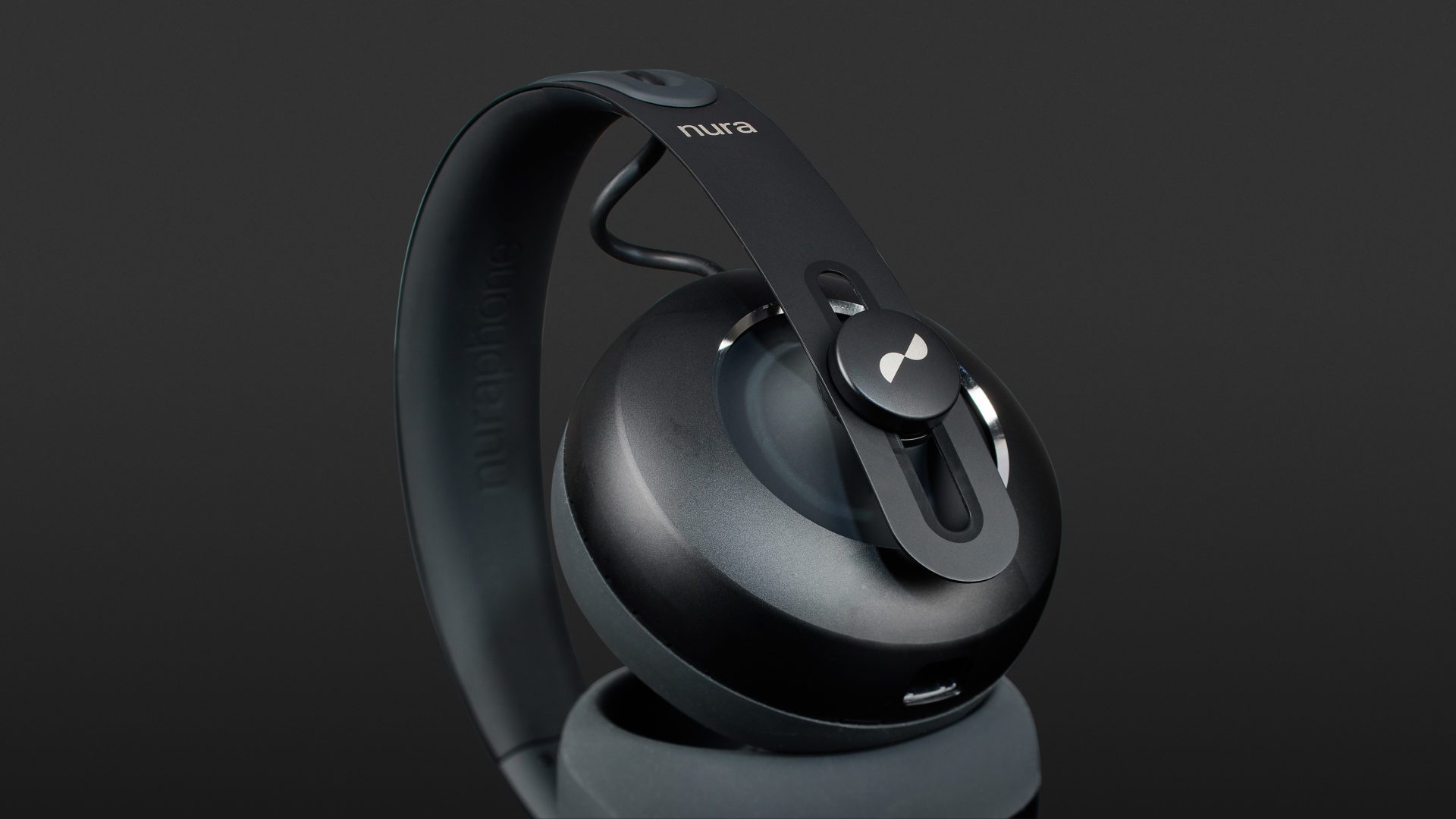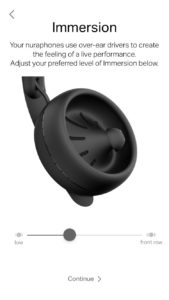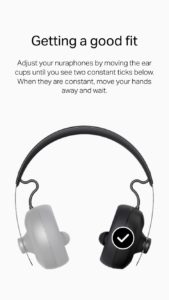Respect! Nura has fundamentally rocked the headphone market and has come up with new approaches at crucial points. The option to adapt the headphones to your personal hearing by evaluating otoacoustic emissions is very exciting. Here, the manufacturer takes up an extremely interesting and meaningful approach, and implements the associated product with remarkable precision and attention to detail. Innovative technology and balanced sound go hand in hand, but some detailed work in handling is still necessary.
Australian manufacturer Nura is made up of a group of scientists and music lovers, who together in 2016 began an ambitious project via Kickstarter that is finally seeing results. The Nuraphone is an innovative headphone concept that combines the advantages of in-ear and over-ear designs. In addition, an internal signal processor, as well as measuring microphones, ensures sound adjustment based on the user’s own hearing apparatus. And since the free G2 update, even noise cancelling can count be counted as one Nuraphone’s many perks.

Overview
The design of the Nuraphone is unusual, to say the least. The headphones use closed ear cups that conceal in-ears that are placed in the ear canal with the use of three plugs. The manufacturer calls this ‘”Inova”. The design works with an inbuilt lithium battery, which is essential for operation. It has a running time of 20 hours and a charge time of three hours. Standard transmission path runs via Bluetooth coed aptX HD. However, it can also be transmitted via analogue connections, Lightning, USB-C or micro-USB with the utilisation of chargeable adapters. Even when using the analogue cable, the Nuraphone must be charged, because its integral electronics always require power.
The workmanship is certainly impressive, with the build quality carried over to the smart transport case with magnetic closure that comes with the device itself. The lightweight construction is based on a padded adjustable aluminium headband and silicone ear cups. In order to ensure an adequate air supply under this so-called “second skin”, there are numerous ventilation slits which, when interacting with music, quietly direct cooling air from outside of the headphones inwards via so-called Tesla valves. The Nuraphone has two external and internal microphones located on each side of the headset. Touch-sensitive sensor points for function controls are also provided at convenient points on the ear cups.
Adjustment to your own ear
The Nuraphone is not the first headphone to advertise itself as being able to adjust frequency response to your own ear. It is, however, the first device that evaluates so-called otoacoustic emissions. The background is fascinating, with the ideas based on the scientific knowledge that the ear itself emits sound waves when it hears. These depend on the incoming frequencies and levels, but are by no means identical to them. They are rather the result of a modulation of the hair cells in the inner ear, which are activated by incoming frequencies, in turn causing the eardrum to vibrate.
Otoacoustic emissions are about 80 dB quieter than incoming transmission signals. They were, in fact, only first detected back in the 1970s, although their existence had been predicted long before that. In practice, they are now an important measurement metric when it comes to infant hearing tests. In the case of Nuraphone, the procedure is much more refined. Emissions are captured and evaluated by extremely sensitive microphones in the auditory canal. The personal hearing device is analysed and then linearised. With this approach, Nura addresses something that most headphones don’t take into account: the individuality of hearing. In addition to noise and age-related degradations of hearing in certain frequency ranges, each person processes sound in an individual way due to their specific ear shape.
Sound
This novel approach means that personalisation of the headphones is an absolute must before you begin. It only takes a few minutes to get started. First, download the associated app for free to your iOS or Android device and create a user account with the manufacturer. After the pairing process, you’ll be guided through the rest of the adjustment steps in a user-friendly manner. Instead of simple test tones, the measuring microphones in the Nuraphone headset capture otoacousitc emissions in response to test tones fed into the system. You only need to perform the measurement in a quiet environment, with the app giving feedback about the correct outside and inside position of the Nuraphone. This is essential for successful measurements. The measurement process itself only takes around a minute, consisting of a series of test tones. The result is an individual hearing curve that is automatically linearised and cannot be changed. Up to three individual profiles can be stored in the app so different users can quickly switch between settings. The hearing profile itself is displayed in the form of a graph showing the hearing sensitivity at certain frequencies.
From now on, the Nuraphone is personalised. This mode can be switched off; however, this does not lead to desirable results as the design of the microphones means they are optimised for the measurement process.
Also switchable are active noise cancelling and social elements, but we’ll get to that shortly. The so-called immersion mode, on the other hand, is infinitely variable and requires further explanation. In addition to the surrounding in-ear drivers, the Nuraphone also features 40mm drivers in the ear cups themselves. These do not really have an active effect on the eardrum but provide added and adjustable stimulation of the outer ear. Thus, an additional sensation of low frequencies is generated. The perceived bass response can be adjusted to taste and ranges from a slight bass boost to massively exaggerated. As a rule, I have turned this parameter up by a quarter, depending on the playback volume. It makes sense to store the settings of the app in the headphones, so you needn’t have to worry about relying on your smartphone all of the time.
The headset itself needs some getting used to, due tot he construction and material. Ultimately, however, it is a good performer in terms of wearing comfort, even if you’re listening for longer periods. On warm days in the summer, the ventilation features of these headphones probably won’t be sufficient to keep you cool, however. Silicone does not completely convince when it comes breathability.
In practice, the Nuraphone scores highly when it comes to convenience. When the headset is put on, it automatically switches on and reactivates a previously existing pairing, informs the user of battery status and even begins music playback. In principle, even pairing with different receivers with fast switching is possible. The same applies to fast pairing. Depending on factors like start sequence of music and the iOS app, there were some interruptions I encountered in playback. These could only be rectified by switching Bluetooth on and off on my iPhone. In this respect, the manufacturer has some improvements to make.
The sensor technology allows individual functions for single and double-click per earpiece, which can be defined with ease via the app. However, there is no provision at the moment for wiping actions. Playback functions, call acceptance and termination, programming and switching of noise-cancelling functions, volume control by clicking and double-clicking are all possible. However, there are some drawbacks. Each time a function is triggered, an unavoidable click is part and parcel. I repeatedly triggered functions when touching the ear cups. Here, however, one can hope that the manufacturer comes up with some solutions in the future. After all, the Nuraphone is functionally updatable. In fact, the manufacturer has already proven it can take things further with the G2 version, which introduces active noise cancelling to the Nuraphone completely free of charge.
Noise Cancelling
The passive noise cancellation of the headphones is quite effective due to the Inova design. It often works better in mid and high frequencies than with established ANC competitors. The update now allows for additional active noise cancelling, while the effect of which has been optimised for low-frequency signals as usual. The cancellation can only be switched on and achieved an effective reduction of external noises. Traffic noise, as well as speech sounds in the immediate vicinity, is pushed far into the background, allowing music to stand out much more clearly. Nevertheless, the Nuraphone does not come close to the industry leaders in certain areas, who often achieve higher levels of cancelling values. In addition, they often work depending on the situation and feature environment-dependent switching. Nonetheless, noise cancelling in noisy environments clearly improves the experience and increases the focus on music reproduction.
A practical feature is the so-called social mode, which uses outdoor microphones to reproduce environmental sounds. This is ideal for communication and public transport. Ideally, the operating mode should be set to touch function. The sound level of the music is slightly reduced and external noise is transmitted clearly to the ear.
Sound
The sound evaluation of the Nuraphone must be carried out when personalistion is switched on, due to the fact that this the only way for the headphones to demonstrate their true strengths. The sound result depends on the degree of immersion. A completely neutral position simply does not exist. Nevertheless, the sound result is impressive. The Nuraphone convinces in particular with its transparency and clear detail, whether that’s drawing out single instruments or voices, or achieving a panorama of sound and allowing multiple elements to play harmoniously together. The headphones are balanced and, at least with low immersive values, quite neutral in frequency response. For some bass pressure, it makes sense to adjust the immersive control slightly, at least when listening in a noisy environments.
While we are on the topic of bass, it’s worth noting the entire range down to the lowest registers are present here. That includes dynamics, contours and comprehensive tonality.
The mids retain the richness of detail you’d want, with a high level of speech intelligibility that doesn’t overemphasise. Even in the treble range, things never sound too harsh, but it does sound fast, open and airy. A harmonious result means these headphones certainly justify the recommended retail price of just under 400 euros. I’d certify that Nuraphone is suitable for use with all genres, whether it’s reproducing dynamic orchestral recordings, jazz trios, rock tracks or dance music. The only critical point is that the Nuraphone is not really designed for loud listening.
At the same time I wouldn’t call Nuraphone the best headphone on the market for its price range. It is well known that even more conventional designs are capable of convincing performance. Nevertheless, the premium sound class in the area of mobile designs is now being given a serious new competitor, whose fresh approach should cause a stir.
Technical specifications
- Ear couplingOver-ear & In-ear
- Typeclosed
- Transducer principledynamic
- Weight without cable329 g
- Cable length120 cm
What's in the box
- USB charging cable
- Travel case
Special features
- BT codec: aptX HD
- optional cables: USB-A, USB-C, micro USB, lightning, cable with mini jacks


















































